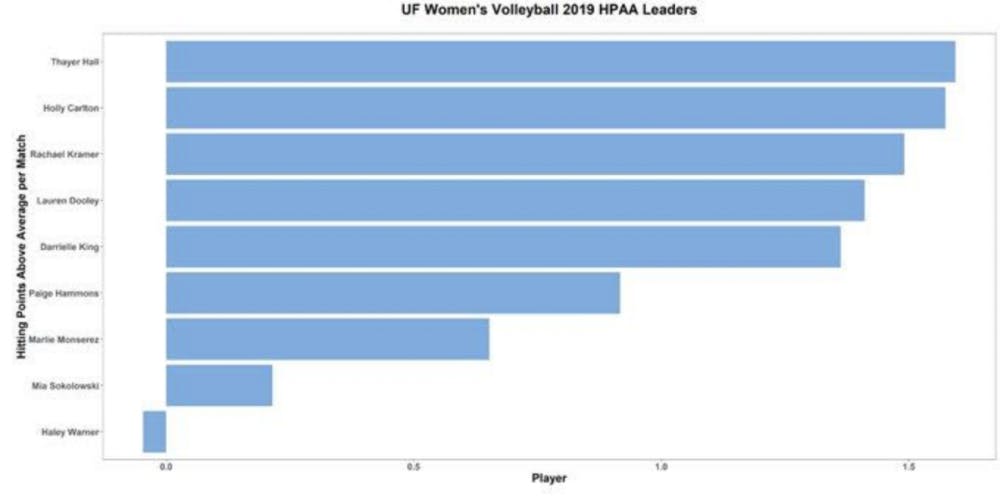What is the best way to evaluate offense in volleyball?
Comparing how many kills a player has to another isn’t fair because they could have more swings. Hitting percentage is a good start, but that is still not necessarily the best answer.
Better players may draw more attention defensively or hit more from low-percentage areas of the court. Defenses are going to be much more prepared for Florida’s star outside hitter Thayer Hall than outside hitters Paige Hammons and Mia Sokolowski.
Twitter user and site manager for SB Nation’s Raw Charge @loserpoints, also known as Alan, came up with a new way to balance both total attacks and hitting percentage: Hitting Points Above Average (HPAA).
So here’s what you need to know about HPAA:
How does it work?
The formula is simple: (Kills - errors) — (Total attacks * .2)
The first half of the formula gives you what Alan calls “hitting points.” The second half results in the number of kills you would expect from an average player for however many attacks they had. The .2 comes from the average hitting percentage nationwide of roughly 20 percent.
Thus, HPAA tells you how many hitting points a player has compared to the average player if they both had the same number of attacks.
But HPAA is also a volume stat. Players who play more have higher HPAAs because they have more attacks and potentially games played.
The solution is to divide HPAA by games played to get the HPAA per match. You end up with similar results, but it also accounts for games played.
For example, let’s take Hall, who has 186 kills and 65 errors on 492 swings. Following the HPAA formula, the result is 22.32, the highest on the team. Dividing it by her 14 matches played gives you an HPAA per match of 1.59, which ranks 20th in the SEC.
So what does this mean, and what can this tell us about the Gators?
The good news for Florida is that it has six players among the top 40 in the SEC by HPAA. No other team has more than five. Hall, Holly Carlton (22.04) and middle blocker Lauren Dooley (18.34) lead the Gators in HPAA.
One of the benefits of HPAA is that it tells us some things that hitting percentage or kills alone wouldn’t tell you. Hall is seventh on the team in hitting percentage out of the nine players with at least 30 total attacks and leads the team in kills. HPAA uses both to determine that, while Hall’s hitting percentage isn’t that great, she is still an effective player in the attack.
However, the problem is that UF doesn’t have any truly elite players, either. Hall is 20th in the conference, with Carlton and Dooley not too far behind at 22nd and 28th, respectively.
HPAA per match gives similar results: Six Florida players are still in the top 40, but only Hall is in the top 20. Carlton (22nd), Kramer (23rd), Dooley (26th) and Dooley (27th) are in the top 30.
“They don’t really have anyone right now getting to that next level,” Alan said in a text. “I think Thayer Hall can be that player but hitting 25 percent isn’t quite enough to get her there. I know she doesn’t always get the best looks, but I’d really like to see that number go up at least a bit.”
He also added, “She’s a great player, she’s only a sophomore, and she’s got all the talent to become a dominant player in the SEC.”
That’s a real problem that Florida faces. The Gators have played matches against Stanford, which has three of the Pac-12’s top 10 players in HPAA per match (including Kathryn Plummer, who is second in the Pac-12), Kentucky, which has two of the conference’s top-10 players in HPAA per match, and Northern Arizona, whose Abby Akin is 12th in the country in HPAA per match.
In those three matches, the Gators are 1-2, with their sole win coming against an otherwise overmatched Northern Arizona squad. Not having a player who can consistently take over a match can kill them in both SEC play and come tournament time.
Another interesting result from HPAA per match is that there wasn’t much of a difference between Florida’s three middle blockers. Early on in the season, UF started King and senior Rachael Kramer, then went with King and Dooley when Kramer was injured. Now the Gators are primarily using Kramer and Dooley.
On the offensive side, there doesn’t seem to be much of a difference. Kramer has the highest HPAA per match (1.49), but Dooley (1.41) and King (1.36) aren’t too far behind. Any differences between the three players likely lies in their defensive play.
Bonus facts: Former UF players Rhamat Alhassan, Alex Holston and Kelly Murphy have three of the four highest career HPAAs in the SEC since 2009. All three are also in the top 40 in the NCAA in that span, with Alhassan in seventh place.
Follow Brendan Farrell on Twitter @Bfarrell727. Contact him at bfarrell@alligator.org.
Courtesy of Alan (@loserpoints), Site Manager @RawCharge






